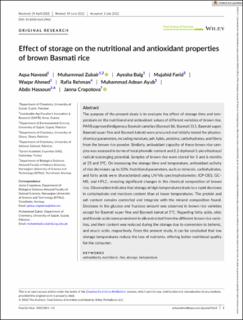| dc.description.abstract | The purpose of the present study is to evaluate the effect of storage time and temperature on the nutritional and antioxidant values of different varieties of brown rice. PARB approved indigenous Basmati varieties (Basmati 86, Basmati 515, Basmati super, Basmati super fine and Basmati kainat) were procured and initially tested for physicochemical parameters, including moisture, ash, lipids, proteins, carbohydrates, and fibers from the brown rice powder. Similarly, antioxidant capacity of these brown rice samples was assessed in terms of total phenolic content and 2,2-diphenyl-1-picrylhydrazyl radical-scavenging potential. Samples of brown rice were stored for 3 and 6 months at 25 and 5°C. On increasing the storage time and temperature, antioxidant activity of rice decreases up to 50%. Nutritional parameters, such as minerals, carbohydrates, and fatty acids were characterized using UV/Vis spectrophotometer, ICP-OES, GC–MS, and HPLC, revealing significant changes in the chemical composition of brown rice. Observation indicates that storage at high temperatures leads to a rapid decrease in carbohydrate and moisture content than at lower temperatures. The protein and ash content remains controlled and integrate with the mineral composition found. Decrease in the glucose and fructose amount was observed in brown rice varieties except for Basmati super fine and Basmati kainat at 5°C. Regarding fatty acids, oleic and linoleic acids were prominent in oils extracted from the different brown rice varieties, and their content was reduced during the storage due to conversion to behenic, and erucic acids, respectively. From the present study, it can be concluded that low storage temperatures reduce the loss of nutrients, offering better nutritional quality for the consumer. | en_US |

